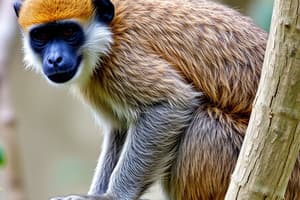Podcast
Questions and Answers
What are the two main concerns for primates in their ecology?
What are the two main concerns for primates in their ecology?
- How to find shelter and how to reproduce
- How/what to eat and how to avoid being eaten (correct)
- How to migrate and how to adapt
- How to socialize and how to communicate
Which component is NOT part of the total energy requirements for organisms?
Which component is NOT part of the total energy requirements for organisms?
- Reproductive effort
- Basal metabolism
- Environmental adaptation (correct)
- Active metabolism
How does the basal metabolic rate (BMR) differ between larger and smaller animals?
How does the basal metabolic rate (BMR) differ between larger and smaller animals?
- Larger animals have higher BMR and higher calories per unit body weight
- BMR is the same regardless of animal size
- Smaller animals have higher BMR and lower energy requirements
- Larger animals have absolutely higher BMR, but lower calories per unit body weight (correct)
What is the primary focus for understanding energy requirements in primates?
What is the primary focus for understanding energy requirements in primates?
What is active metabolic rate (AMR) primarily dependent on?
What is active metabolic rate (AMR) primarily dependent on?
Which group of primates typically has higher energy requirements than predicted for their size?
Which group of primates typically has higher energy requirements than predicted for their size?
What effect does predation avoidance have on primate social systems?
What effect does predation avoidance have on primate social systems?
Which of the following is NOT a method primates use to secure energy from their environment?
Which of the following is NOT a method primates use to secure energy from their environment?
What is one of the main benefits of sociality in animal groups?
What is one of the main benefits of sociality in animal groups?
What does the term 'dilution' refer to in the context of predator avoidance?
What does the term 'dilution' refer to in the context of predator avoidance?
What trade-off is associated with living in large groups?
What trade-off is associated with living in large groups?
What is a polyspecific association?
What is a polyspecific association?
How can sociality influence the evolution of primates?
How can sociality influence the evolution of primates?
What is the additional calorie cost for females during lactation?
What is the additional calorie cost for females during lactation?
Which nutrients must be obtained through the diet as they cannot be synthesized by the body?
Which nutrients must be obtained through the diet as they cannot be synthesized by the body?
What are alkaloids known to disrupt?
What are alkaloids known to disrupt?
Which food type do most primates rely on that is high in protein?
Which food type do most primates rely on that is high in protein?
What is typically higher in concentration in mature leaves compared to fruits?
What is typically higher in concentration in mature leaves compared to fruits?
Which food source is considered high in carbohydrates for primates?
Which food source is considered high in carbohydrates for primates?
Primates' reliance on certain food types often varies. Which is a common pairing for many Strepsirrhines?
Primates' reliance on certain food types often varies. Which is a common pairing for many Strepsirrhines?
Which of the following is a common plant defense compound that reduces digestibility?
Which of the following is a common plant defense compound that reduces digestibility?
Which type of food is classified under folivory for primates?
Which type of food is classified under folivory for primates?
What type of nutrient is iron essential for synthesizing?
What type of nutrient is iron essential for synthesizing?
What term describes primates that primarily consume leaves?
What term describes primates that primarily consume leaves?
Which diet is expected to require the least amount of time for processing food?
Which diet is expected to require the least amount of time for processing food?
What is a key characteristic of larger animals regarding their food processing?
What is a key characteristic of larger animals regarding their food processing?
During periods of food scarcity, what may primates do?
During periods of food scarcity, what may primates do?
In terms of food availability in tropical forests, which statement is true?
In terms of food availability in tropical forests, which statement is true?
What does the term 'home range' refer to?
What does the term 'home range' refer to?
What is a common fallback food for primates during scarce seasons?
What is a common fallback food for primates during scarce seasons?
Which diet type has the largest average home or day range?
Which diet type has the largest average home or day range?
What primarily limits the diet of smaller animals compared to larger ones?
What primarily limits the diet of smaller animals compared to larger ones?
How does body size relate to basal metabolic rate (BMR) in primates?
How does body size relate to basal metabolic rate (BMR) in primates?
What primarily influences the size of a primate's home range?
What primarily influences the size of a primate's home range?
What is a potential cost of being territorial for primates?
What is a potential cost of being territorial for primates?
Which primate is identified as a frugivore?
Which primate is identified as a frugivore?
Which of the following statements about territoriality is true?
Which of the following statements about territoriality is true?
For male primates, the primary benefit of territoriality is access to what?
For male primates, the primary benefit of territoriality is access to what?
Which strategy is NOT commonly used by primates to avoid predators?
Which strategy is NOT commonly used by primates to avoid predators?
Which factor is indicated to increase predation risk in primates?
Which factor is indicated to increase predation risk in primates?
How does resource distribution influence territoriality?
How does resource distribution influence territoriality?
What is a significant factor that affects a primate's energy requirements?
What is a significant factor that affects a primate's energy requirements?
What is the typical day range for a Howler Monkey?
What is the typical day range for a Howler Monkey?
Flashcards are hidden until you start studying
Study Notes
Primate Ecology Definitions
- Primate ecology studies how primates interact with their environment, including physical habitat and other organisms
- It focuses on how primates make a living and how ecological variables influence social systems
Energy Requirements
- Food supplies energy essential for growth, survival & reproduction
- Four main energy components:
- Basal Metabolic Rate (BMR): energy for basic body maintenance at rest (e.g., maintaining body temperature)
- Active Metabolic Rate (AMR): energy required for daily activities (e.g., locomotion, digestion)
- Growth Rate: energy required to build new tissue (higher for juveniles)
- Reproductive Effort: additional energy for females (higher during pregnancy and lactation)
Nutritional Requirements
- Diet must satisfy energy requirements and provide essential nutrients
- Protein/amino acids: for growth, reproduction, regulation of bodily functions
- Fats, oils, & carbohydrates: provide energy
- Trace vitamins & minerals: vital for specific physiological functions
- Secondary compounds: plant defenses that can be toxic (alkaloids, tannins) and are highest in mature leaves and seeds
Primate Foods
- Fruits (frugivory)
- Leaves (folivory): different types of leaves vary in digestibility
- Young leaves: more easily digested proteins and sugars
- Mature leaves: high cellulose content requiring specialized adaptations
- Insects (insectivory): social insects vs. solitary insects
- Other foods: grasses, tubers, corms, gum, vertebrates, bark, fungus, soil (for minerals)
- Water: directly or through food items
Generalizations about Primate Diets
- Most primates rely on one food type high in protein and one high in carbohydrates.
- Example: Strepsirrhines (gum/fruit + insects); Monkeys/Apes (fruit + insects/young leaves)
- Primates rely more heavily on some types of foods than others (e.g., chimpanzees eat ripe fruit preferentially, aye-ayes eat grubs)
- In general, insectivores < frugivores < folivores:
- Smaller animals require smaller but high-quality foods (easily processed)
- Larger animals can process lower quality food more slowly
Food Availability
- Food varies in space and time:
- Patchy distribution: unpredictable availability and location
- Seasonality: influenced by day length and rainfall
- Keystone Resources: fall-back food sources during scarce seasons (e.g., Ficus)
Range and Territoriality
- Range: the geographic area used by a group
- Home range: total area used
- Day range: area used on a daily basis
- Territoriality: defense of a home range
- Some primates are territorial (e.g., gibbons)
- Other’s home ranges overlap (e.g., capuchin monkeys)
- Food distribution influences territoriality:
- Even food distribution: not defensible
- Clumped, patchy food: more defensible
- Costs and benefits of territoriality:
- Costs: Vigilance, advertising presence, defense
- Benefits: Exclusive access to resources, preventing competition
- The benefits must outweigh the costs for an individual to be territorial
Predation Avoidance
- Predation is a significant source of mortality for primates
- Factors increasing predation risk: being terrestrial, smaller group size
- Predation Avoidance mechanisms:
- Alarm calls: (e.g., vervets)
- Swarming: defense in groups
- Interspecific associations: joining with other primate species for mutual protection (e.g., red colobus and diana monkeys)
Sociality and Predation
- Groups provide safety from predators:
- Detection: more eyes on the lookout
- Deterrence: swarming or mobbing predators
- Dilution: reducing individual risk in larger groups
- Trade-offs between predation and food:
- Small groups/solitary animals: high predation risk, low intragroup food competition
- Large groups: lower predation risk, increased competition for food
- Optimal group size: balance of predation risk and competition
Costs and Benefits of Sociality
- Benefits:
- Resource control: access to food and territories
- Predator avoidance
- Access to mates
- Costs:
- Competition for resources
- Disease risk
- Social conflicts (e.g., infanticide, cuckoldry)
Summary
- Primate feeding strategies and predator avoidance influence range size, territoriality, and group size
- There are trade-offs for territoriality and group size
- Competition for defensible resources occurs within and between groups
- Social behavior in primates is likely driven by a combination of feeding competition and predation pressure
Studying That Suits You
Use AI to generate personalized quizzes and flashcards to suit your learning preferences.




